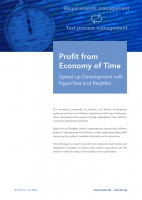All you need to know about effective requirements management for your test process
As you know, requirements management is a fundamental part of every test process. It comprises the definition of requirements, test preparation and test planning as you can see in the figure below. The first two phases are minting your later scheduling and resource planning because this is when you determine the cost-intensive time your unit under test spends on the test bed.
Here you'll find everything you need to know about what actually makes an effective requirements management and how you use it to significantly improve the efficiency and quality of your entire test process.

Lay the foundation for your efficient test process with careful definition, test preparation and planning
The ideal way to start defining your requirements is to import your test requirements or to enter them in a dialog. You usually have two different options: either you import your requirements manually or you receive them automatically from a product lifecycle management system or any other system that is part of the systems engineering process. Of course, you can just as well import the data from an existing requirements management system and add test-specific information.
In the next step, you assign specific resources to the test order – that is measurement devices, test items, test beds, test instructions, auxiliary test tools, suitable test methods, and the required personnel. Test methods can range from a simple set-up instruction with a subsequent measurement instruction through to complex test sequences with programmatically running test procedures that define individual test steps, loops and conditions for the test run.
Efficiently align the resources and schedules of your test process
The resource requirements and the scheduling of your tests are reconciled with other tests in order to coordinate them based on the availability of test beds, units under test, measurement devices, other equipment and the required personnel.
It is advisable to cover several requirements by one single test in order to minimize the number of tests to be executed and, thereby, reduce set-up times to an unavoidable minimum. Mind you, the quantities available of the resources you need for your tests are not infinite – neither in terms of time nor in terms of space.

Whitepaper - Digitalization in requirements and test process management
The increasing complexity of products and shorter development cycles present test and validation departments with major challenges. Here, improved process support through digitalization can unlock an enormous optimization potential.
In our whitepaper you will learn how to digitalize your requirements at an early stage with HyperTest (Werum Software & Systems AG) and ReqMan (:em engineering methods AG), and how to accelerate the validation and make the entire product development process more agile and efficient.
What you should keep in mind so your carefully thought-out requirements management really pays off throughout your entire test process
Once you have defined your requirements and have prepared and planned your tests, your test process passes over into the "execution" process step. Here, your test bed personnel executes the tasks assigned to them.
From now on, your test orders will be linked with countless additional data throughout the entire test process. That includes the measurement data acquired, analysis results, photos, comments, release information, findings and final test reports. To make sure your carefully thought-out requirements management really improves the efficiency and quality of your whole test process you should at this point put your trust in a smooth test data management. Take care that the requirements previously assigned to each test can be easily and reliably traced at any time and in all test phases. That is an accurate and uncomplicated way to check that all requirements are satisfied. You can eliminate potential errors at an early stage and execute your tests with maximum efficiency and economy of resources.
If you are interested in a test data management system that allows all that come true , read more about HyperTest® Boost.
